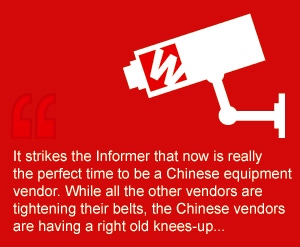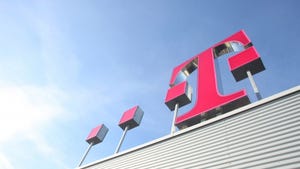Ups and downs update from May 2009
The Informer keeps seeing these financial crisis-induced marketing emails that say things like: "Now is the perfect time to innovate!" or "Now is the perfect time to implement this cost management solution!". But it strikes the Informer that what now is really the perfect time for is to be a Chinese equipment vendor. While all the other vendors are loosening their collars and tightening their belts, and shedding staff like a dog sheds hair (unless it's a Portuguese Water Dog, of course), the Chinese vendors are having a right old knees-up.
May 1, 2009

By The Informer
The Informer keeps seeing these financial crisis-induced marketing emails that say things like: “Now is the perfect time to innovate!” or “Now is the perfect time to implement this cost management solution!”. But it strikes the Informer that what now is really the perfect time for is to be a Chinese equipment vendor. While all the other vendors are loosening their collars and tightening their belts, and shedding staff like a dog sheds hair (unless it’s a Portuguese Water Dog, of course), the Chinese vendors are having a right old knees-up.
Huawei and ZTE have both got lavish credit facilities from Chinese state banks, enabling them to offer tasty vendor financing to operators looking for attractive rollout models, which is bad news for the Western players. And then, this week, ZTE popped out some results, showing that its quarterly profits are up by 29 per cent, its revenues up by 35 per cent and its quarterly handset shipments up by 30 per cent.
The firm shipped 10 million terminals in Q1 this year, 68 per cent of which went overseas – to more than 100 countries, it said. It also moved two million data cards. These numbers went some way to explaining the firm’s bumper results, with quarterly revenues hitting US$1.71bn and profit coming in at $11.54m.
Contrast these year-on-years with the performance of Western stalwart Ericsson, whose profits dropped by more than ZTE’s went up. Still, despite being 30 per cent down on Q108, Ericsson’s profits were much larger than ZTE’s, at $223.4m, as were its sales at $6.16bn. The sales were actually up 12 per cent, which means Ericsson is getting better at losing money.
It might have something to do with the firm’s exposure to two troubled joint ventures. Ericsson took a hit on its handset JV Sony Ericsson, which is being hurt by flaccid demand, while its silicon outfit, ST-Ericsson, started life with an $89m loss, hit by the same problem. On the upside, said Carl-Henric Svanberg, Ericsson’s CEO, infrastructure sales are stable and demand for professional services, which generates somewhere in the region of one third of the firm’s revenue, is on the up.
Things remain bleak at Motorola, meanwhile. Actually, that sentence is really all you need on this story – but here’s a few numbers to satisfy your bloodlust: First quarter handset sales were down 45 per cent year on year, at $1.8bn, with the unit posting an operating loss of $509m, which is $91m worse than Q1 last year. The US firm shipped 14.7 million units, putting its own global market share at just six per cent.
Sales at the Home and Networks Mobility unit, which houses Motorola’s infrastructure business, were down 16 per cent at $2bn. The unit turned a profit, though, of $115m, down from $153m for the same period last year.
And as we continue our descent down the creaking ladder of woes, why don’t we stop and teeter awhile on the Nortel rung. Sheltering from the global financial storm in the safe harbour of Chapter 11, the Canadian firm was this week granted another extension, allowing it to retain its berth until the end of July while it tries to come up with a solution to its troubles that will appease its creditors.
This week it has been rumoured that part of this solution might be a departure from JV LG-Nortel, the Korean outfit it runs with LG Electronics. Nortel has a controlling stake in the firm and the word on the street is that it would happily forego this stake in return for $1bn.
Nokia continued with its own cost saving strategy plan this week, with 450 staff reluctantly seeing the sense of it and leaving their jobs. The firm’s internal IT and Compatibility & Industry Collaboration unit is being hit this time around, which is odd, given that it also pledged to make better use of third parties as another way of managing its costs. How’s it going to build relationships with third parties if the Industry Collaboration unit’s been lopped off? The Informer’s sure Nokia’s thought it all though.
A while back, you may remember – in economically happier times – Nokia splurged more than $7bn on mapping firm Navteq. This week Navteq won a deal with Nokia’s rival Samsung that will see the Korean vendor gain access to mapping data for all 76 countries in the Navteq database for use on its handsets.
Samsung was also in the news this week for unveiling its first Android handset, doubling the number of vendors with Android phones on the market, and bringing the number of those phones to three. Samsung’s I7500 will go on sale with O2 Germany in June. The number of Android phones available is still well below expectations, although Motorola did say during its results announcement that it would have a range of handsets built on the platform available by Christmas this year.
The first Android phone, the G1, has sold 100,000 units in the UK in its first six months, according to T-Mobile UK, which has exclusivity on the handset. A raft of new features are set to be released for the handset this month, including touch screen keypad capabilities and video record and playback, with version 1.5 of the Android software, which has been nick-named cupcake.
T-Mo also said it would be bringing a new Android handset to market later this year, which could well me the Samsung model. The other Android on the handset, the Magic, is offered exclusively by Vodafone. HTC, manufacturer of the Magic and the G1 put out its results this week, with total revenues hitting $949.7m, translating into profits of $147.3m – down from $207.4m on Q108.
The three Android phones all bear a certain resemblance to the Apple iPhone that they seek to displace in the hearts of touch screen aficionados everywhere. But the Android community has a way to go before it can claim, as Apple did this week, one billion downloads from its App Store since it launched in August last year. Currently there are more than 35,000 applications on offer, in 77 countries.
Analyst firm Juniper Research said this week that it reckons direct and indirect revenues from mobile applications will hit more than $25bn by 2014. The firm said that, while the majority of app revenues today are accrued from one-off downloads, the increasing use of in app billing will enable incremental revenues from additional content and value added services (VAS) providing the dominant revenue stream by 2011.
Juniper also believes that many Tier 1 operators would seek to deploy their own app stores in a bid to maintain content revenue share, however, the researcher believes that in the longer term, the greatest benefits to operators would be derived from data revenues associated with app usage rather than from the retail price of apps and content – as long as operators rejected the walled garden approach.
This week, telecoms.com spoke to Jay Seaton, chief marketing officer at mobile messaging firm Airwide Solutions, which recently commissioned research revealing that almost all operators expect to keep some degree of control over app store environments.
While around 45 per cent of mobile operators expect to directly control less than ten per cent of the apps and services made available via the app store model, some 36 per cent of carriers want to control 20-30 per cent. A poll currently running on telecoms.com suggests the industry is divided equally in its belief as to which types of company will control the app store environment, with handset vendors, platform vendors and operators each having roughly one third of the vote.
On the silicon side of things, Qualcomm and Broadcom have decided to celebrate May Day not by dancing round a pole in an ancient fertility rite but by pledging to play nice having spent the last few years fattening up a phalanx of lawyers with a tedious IP dispute. The two firms have agreed that they will no longer assert their patents against each other, and Qualcomm’s beer and peanuts fund will be depleted by $891m over the next four years as it pays Broadcom what it has been deemed to owe.
Finally, some good news from Alcatel Lucent. And that’s ‘finally’ in the sense that this is the last story, rather than the sense that the Informer’s been waiting for what seems like years for some good news from Alcatel Lucent. The Franco-US JV this week announced that it had secured infrastructure deals with Chinas Mobile and Telecom worth $1.7bn.
Under the agreements, Alcatel-Lucent will provide network upgrades, integration and maintenance services over the course of 2009. China Mobile and China Telecom were granted 3G licenses in January, to roll out TD-SCDMA and CDMA/EV-DO technologies respectively.
The deal with China Mobile, valued at approximately $1bn, will see Alcatel-Lucent provide GSM/EDGE infrastructure, TD-SCDMA kit, optical, microwave and IP transmission offerings, application platforms and related services. The agreement with China Telecom, accounting for the remaining $700m, will see the vendor supply 3G CDMA/EV-DO networking equipment, application platforms, optical and IP transmission platforms and network maintenance services.
Whether it had to compete with the kind of finance deals that Chinese vendors are able to offer was not made clear.
Take care
The Informer
Read more about:
DiscussionYou May Also Like






.png?width=300&auto=webp&quality=80&disable=upscale)


_1.jpg?width=300&auto=webp&quality=80&disable=upscale)


.png?width=800&auto=webp&quality=80&disable=upscale)